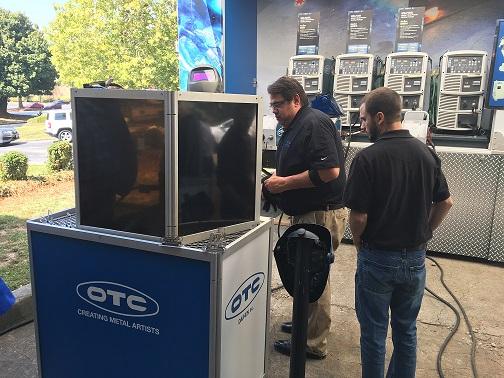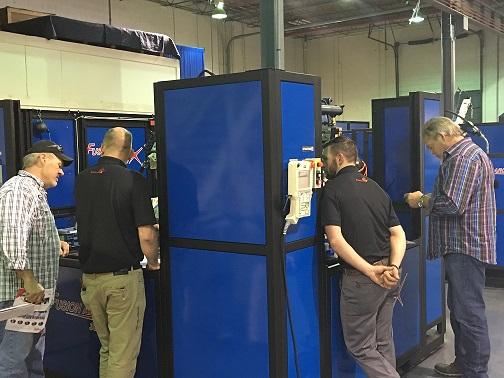Editor-in-Chief
- FMA
- The Fabricator
- FABTECH
- Canadian Metalworking
Categories
- Additive Manufacturing
- Aluminum Welding
- Arc Welding
- Assembly and Joining
- Automation and Robotics
- Bending and Forming
- Consumables
- Cutting and Weld Prep
- Electric Vehicles
- En Español
- Finishing
- Hydroforming
- Laser Cutting
- Laser Welding
- Machining
- Manufacturing Software
- Materials Handling
- Metals/Materials
- Oxyfuel Cutting
- Plasma Cutting
- Power Tools
- Punching and Other Holemaking
- Roll Forming
- Safety
- Sawing
- Shearing
- Shop Management
- Testing and Measuring
- Tube and Pipe Fabrication
- Tube and Pipe Production
- Waterjet Cutting
Industry Directory
Webcasts
Podcasts
FAB 40
Advertise
Subscribe
Account Login
Search
Exploring welding efficiencies for small to midsized shops
Cost-effective fixture creation and new power source technology are just two examples of technology advancements that can help fabricators
- By Dan Davis
- October 9, 2017
- Article
- Arc Welding

Figure 1. Attendees at the Capital Machine Technologies Welding Seminar had the opportunity to test out the latest gas metal arc welding technologies from OTC Daihen.
Many metal fabricators are not unfamiliar with automation and technology developments in material handling, metal cutting, and bending. They have seen what can be accomplished with these advancements and have put them to use in their own shops. They know the importance of trying to find new efficiencies in the face of greater competition from the shop down the street or maybe across an ocean.
But can they say the same about welding? Are these shops using old power sources, and are the welders relying on the same techniques?
Capital Machine Technologies, a machine tool distributor based in Tampa, Fla., recognizes that finding efficiencies in the welding process might be good business for these small to medium-sized fab shops. That’s why it hosted fabricators at its Atlanta Technology Center Sept. 19-20 for a welding seminar and has made plans to do the same in early 2018 at its locations in Dallas and Tampa.
In an opening address, Scott Mazzulla, president and CEO, Hobart Institute of Welding Technology, Troy, Ohio, stressed to the fabricators in attendance that just because the topic of conversation for the day was technology advancements, they still should be concerned about attracting and retaining talented welders. Even with robots becoming easier to program and more affordable, the best robot technician is someone with a welding background.
“The robot’s job is to deliver the weld process, but without an optimal weld process, there is not going to be a customer,” Mazzulla said.
This is where a welder’s experience and skill can help out. They understand the importance of torch angles, work distance, and arc length when the robotic arm is laying a bead. They can hear the arc and sense if something is wrong. They can read a puddle to determine if results are meeting original expectations. In the end, they can be taught to program and maintain the robotic equipment, he said.
“A good welder plus robot application training equals an intelligent technical welder,” Mazzulla added.
Rob Thompson, CEO, Camtek Software, provided an overview of his company’s fixture-design software. Using only a 3-D model of a part, the software creates a fixture design comprised of 2-D blades, which can be laser-, plasma-, or waterjet-cut from any sort of metal stock, that are connected to a mating base plate. The top profile of each blade matches the underside of the component at the blade’s insertion position, creating a sort of cradle onto which the weldments are placed.
“Fixtures are a necessary evil,” Thompson said. “We want to make them easier to make.”
Thompson contended that the software can help a shop reduce lead times for creating fixtures, especially if it outsources the design and build. If the shop makes their own fixtures, he said, it clears the work from the company’s own machine shop because the parts are cut on a table and then assembled in a matter of minutes.

Figure 2. The welding seminar also gave fabricators a chance to see different robotic welding cell configurations that might make sense for a small to medium-sized fab shop.
To close the welding seminar, Mike Monnin, general manager, sales and marketing, OTC Daihen, discussed his company’s Synchro-Feed technology as a way to minimize welding spatter and avoid postweld cleanup (see Figure 1). This new development is centered around a servo-drive wire feeder on the torch body that advances the welding wire forward to create an arc and then quickly retracts the wire while synchronizing with a specialized current waveform to create a short-circuit transfer with minimal weld spatter.
Fabricators who might be interested in attending future seminars (see Figure 2) can visit www.capitalmachine.com/weldingseminars for more details.
About the Author

Dan Davis
2135 Point Blvd.
Elgin, IL 60123
815-227-8281
Dan Davis is editor-in-chief of The Fabricator, the industry's most widely circulated metal fabricating magazine, and its sister publications, The Tube & Pipe Journal and The Welder. He has been with the publications since April 2002.
subscribe now

The Fabricator is North America's leading magazine for the metal forming and fabricating industry. The magazine delivers the news, technical articles, and case histories that enable fabricators to do their jobs more efficiently. The Fabricator has served the industry since 1970.
start your free subscription- Stay connected from anywhere

Easily access valuable industry resources now with full access to the digital edition of The Fabricator.

Easily access valuable industry resources now with full access to the digital edition of The Welder.

Easily access valuable industry resources now with full access to the digital edition of The Tube and Pipe Journal.
- Podcasting
- Podcast:
- The Fabricator Podcast
- Published:
- 04/16/2024
- Running Time:
- 63:29
In this episode of The Fabricator Podcast, Caleb Chamberlain, co-founder and CEO of OSH Cut, discusses his company’s...
- Trending Articles
Tips for creating sheet metal tubes with perforations

Supporting the metal fabricating industry through FMA

JM Steel triples capacity for solar energy projects at Pennsylvania facility

Fabricating favorite childhood memories

Omco Solar opens second Alabama manufacturing facility

- Industry Events
16th Annual Safety Conference
- April 30 - May 1, 2024
- Elgin,
Pipe and Tube Conference
- May 21 - 22, 2024
- Omaha, NE
World-Class Roll Forming Workshop
- June 5 - 6, 2024
- Louisville, KY
Advanced Laser Application Workshop
- June 25 - 27, 2024
- Novi, MI


























